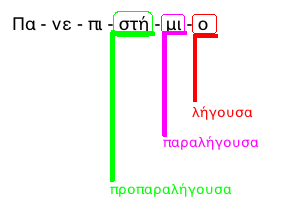Language/Ancient-greek-to-1453/Grammar/Accents-in-Ancient-Greek
The accentuation of Ancient Greek[edit | edit source]
The accentuation of Ancient Greek is an important aspect of the language. Unlike modern Greek, Ancient Greek was written only in capital letters and did not use accents. The use of accents started in Alexandria around 200 BC, and the people of Byzantium were among the first to use them.
There were two primary reasons why accents were introduced in Ancient Greek. Firstly, the Greeks themselves needed guidance on how to correctly pronounce words that they did not commonly use. Secondly, it may have been introduced to aid in the language learning process for foreigners.
There are three types of accents in Ancient Greek. Every Greek word, with the exception of accusative ones, has a syllable with an accent. The types of accents include:
- οξεία (΄ acute accent): placed on the syllable with the highest pitch. For example: λύω (to untie), πατήρ (father).
- βαρεία (`) replaces the acute accent at the end of a word (excluding enclitic ones). For example: ἀγαθὸς ἄνθρωπος (a good man).
- περισπωμένη (῀ circumflex accent): placed on a long vowel or diphthong. For example: καλῶς (well).
An accented word in Ancient Greek is classified into one of five categories:
- Oxyton: emphasized on the last syllable. For example: πα-τήρ (father).
- Perispomene: carries the circumflex accent on the last long vowel. For example: καλῶς (well).
- Paroxyton: carries the accent on the penultimate vowel (penultimate). For example: λό-γος (word).
- Properispomene: carries the circumflex accent on the penultimate long vowel. For example: δῶρον (gift).
- Proparoxyton: places the acute accent on the antepenultimate vowel. For example: ἄν-θρω-πος (human).
It is important to note that no words are emphasized on the preposition in Ancient Greek.
The three accent types[edit | edit source]
This is a table showing the placement of the stress accent in three different types of Ancient Greek words. The first row lists the three accent types, and the subsequent rows provide examples of words with those accents.
The three accent types are:
ΠΠΛ (proparoxyton): refers to words where the stress accent falls on the antepenultimate (third-to-last) syllable. ΠΛ (paroxyton): refers to words where the stress accent falls on the penultimate (second-to-last) syllable. Λ (oxyton): refers to words where the stress accent falls on the ultimate (last) syllable. The table provides examples of each accent type using the word λέγομεν (legomen), which means "we say" in English. The accents change depending on the tense, voice, and person of the verb.
| ΠΠΛ | ΠΛ | Λ | ||
| λέ | γο | μεν | ||
| ἐ | λέ | γο | μεν | |
| ἐ | λε | γό | με | θα |
- ΠΠΛ = προπαραλήγουσα (proparoxyton)
- ΠΛ = παραλήγουσα (paroxyton)
- Λ = λήγουσα (oxyton)
Videos about Ancien Greek accents use[edit | edit source]
Author[edit source]
- Ευγενική χορηγία που στοχεύει να βοηθήσει μαθητές ή μη, απανταχού της Γης, που επιδίδονται στην εκμάθηση της ελληνικής γλώσσας!
- Contribution bénévole visant à aider les personnes, partout dans le monde, qui sont engagées dans l'apprentissage de la langue grecque !
- Voluntary contribution aimed at helping people, all over the world, who are committed to learning the Greek language!
Other Lessons[edit | edit source]
- Orthographic signs: Spirits
- Conjunctions
- Gender
- The degrees of adjectives in Ancient Greek
- Adverbs formed from adjectives
- Personal pronouns
- Future Tense
- Ancient Greek Alphabet
- Ancient Greek Correlatives
- Numeral Adjectives

